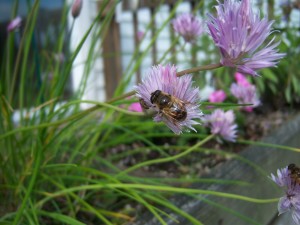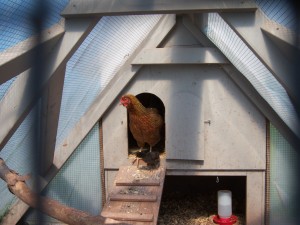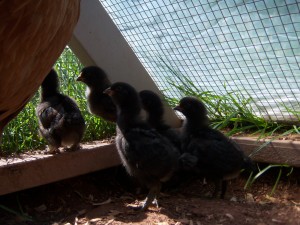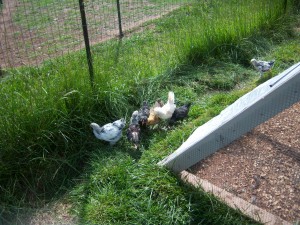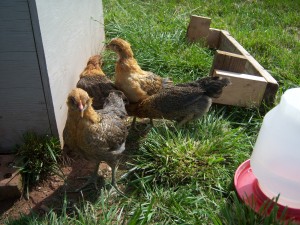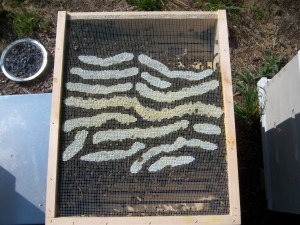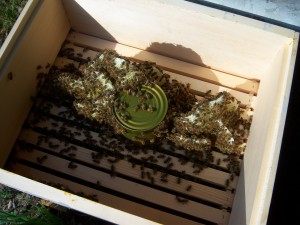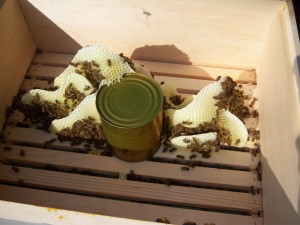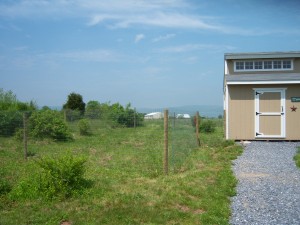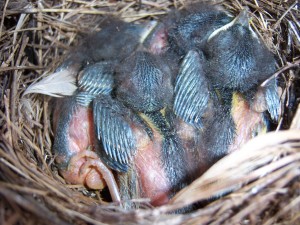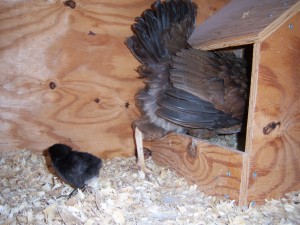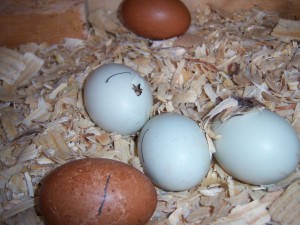todd
Warning: Missing argument 2 for wpdb::prepare(), called in D:\home\littleluceyfarm.com\wwwroot\blog\wp-content\themes\mystique\core\Atom.php on line 2280 and defined in D:\home\littleluceyfarm.com\wwwroot\blog\wp-includes\wp-db.php on line 1210 Warning: Missing argument 2 for wpdb::prepare(), called in D:\home\littleluceyfarm.com\wwwroot\blog\wp-content\themes\mystique\core\Atom.php on line 2280 and defined in D:\home\littleluceyfarm.com\wwwroot\blog\wp-includes\wp-db.php on line 1210 (6 comments, 80 posts)
This user hasn't shared any profile information
Posts by todd

Hoverflies
0The herbs on our deck are blooming including the pretty violet flowers atop the slender chive stalks. I was excited to see several of my honeybees enjoying the flowers. When I looked a little closer, they appeared to be drones (male honeybees) with their large bodies and large black eyes. Then upon even closer inspection, I decided that they weren’t bees at all. I think they were hoverflies. I found a nice website with pictures of lots of different types of hoverflies at: http://www.microscopy-uk.org.uk/mag/artmay07/cd-hoverflies.html. The ones I saw seemed a little different than all the pictures, but there is a lot of variety in this family. One of the major differences between bees and flies is that bees have two sets of wings, whereas flies have only one.
Swarm number 5
0They just keep coming … and going. I thought I had seen my last swarm, but number five left my third hive (Georgia bees installed in March) and landed on the same magic bee bush as the previous four swarms. I had just received some new woodenware, so I quickly assembled four boxes and then painted them to get them ready for the swarm. It was about three or four hours later when I went out to capture the swarm in a nuc box, but they had already departed for a new home.
I am pretty sure that the swarm had just left the hive when I saw it this morning. There were lots of bees in the air, lots around hive 3, and they seemed to be collecting on the bush. In about 15 minutes, there were noticeably fewer bees in the air and around the hive and bush. It certainly looked like they had just swarmed and settled down. However, a half hour later, I saw a waggle dance on one section of the swarm. I didn’t look on other parts of the swarm. If they had just swarmed, how could a scout be doing a waggle dance already? I don’t know. I didn’t really want another hive, but I surely didn’t want to lose another half of my Georgia bees.
The previous swarm from that hive was 19 days ago. At best the new queen has only been laying for a few days or maybe a week. Now there will be another approximately 14 days until another new queen will start laying eggs. So in two weeks, that hive will have gone about a month without new brood (possibly a few days worth of eggs in the middle). The rest of the bees will be pretty old. It seems like I should expect a population crash and slow rebuild.
This is the hive that has the burr comb in the feeding box. I looked at it today and I saw a little of it capped with honey, but lots of it looking mostly empty. I was kinda hoping that it was all going to be capped honey by now. I recently installed a new medium brood box between the deep brood box and the feeding box, hoping to prevent swarming and giving them plenty of expansion space. Apparently, I was too late.
I also moved the first two hives forward about two feet to give myself more room to work on the hives from behind. Again, I had the chance to see what was going on in the supers I put on a couple of months ago. There was still no nectar being stored there. Below the super there are two deep brood boxes. I removed the super and then the top brood box. It must have weighed 50 pounds. So no honey in the super, but a brood box with lots of honey. I didn’t look at the frames today. The second hive was similar but not as heavy – perhaps only 30 pounds in the top brood box. Both lower brood boxes were lighter than the upper boxes, but, again, I didn’t inspect further. That will be another day soon.
I need to move the three smaller hives forward, too. I might be able to just lift them intact and set them on the new stand. They are not nearly as heavy as the first two hives.

Filling out the garden
0This past weekend we planted most of the garden space. We have been harvesting radishes almost daily, but the garden has not produced anything else yet. The spinach and lettuce didn’t do very well this year. We didn’t plant much and something ate the tender little tops once or twice which didn’t help. Three of the six lettuce plants that I bought at the store died suddenly. They were chewed off or rotted right at ground level. The beets didn’t germinate very well, but the few that did have finally started to grow a little bit. We might end up with 10 beets. There were also two small eggplant plants that had the tops eaten down. The first plant before I put up a two foot fence and the second one after I put up the fence. Something seemed to have climbed over the fence, pulling it down somewhat in the process. I reinforced it and I am hoping that will be enough. I am also hoping that the little plants come back. I bought one replacement today. This was all in the small raised bed garden.
The main garden plot was filled out with a bunch of tomato plants, peppers, edamame (soy beans), and lima beans. The onions, broccoli and brussels sprouts look pretty good, but the onions are sending up flower stalks. We snapped them off this year although Joni thinks that it might not help. Maybe they are already slowing down bulb development. We’ll see. This is the first year trying broccoli and brussels sprouts so we shall see how they do. I am expecting a great big green plant with some small barely harvestable parts, but maybe I will be surprised. Not setting my sights too high for these.
We spaced out the tomato plants a little wider this year and put some rows of peppers in between. We are really looking forward to harvesting and canning lots of tomatoes, tomato sauce and salsa. We planted six Roma plants, a few heirloom varieties, a Better Boy, Early girl, Supersonic, a Cupid grape tomato plant. We planted several orange bell peppers along with a Jalapeno, a couple of sweet banana and a Hunganian Wax pepper.
In the secondary garden area, we planted a second row of peas and put up a trellis. The original triple row of sugar peas are doing pretty well. I’m not sure how well the three plants will do climbing over each other. It might be hard to find the peas in all that tangle. We planted a half row of Derby bush beans with a half row of Fordhook lima beans and another half row of something (maybe a different bush bean), but I left a row and a half for planting in two week intervals. I hope I can stick to the schedule. Right in the middle row I planted a series of viney plants. From west to each it contains: Turkish eggplant (seeds), watermelon, Blenheim Orange melon, Zephyr squash, Gurnet’s Lil’ Sweet cantaloupe, and Miss Pickler “Pioneer” cucumbers. That’s going to be a jungle in a couple of months! I can’t wait to hack my way through that erea in search of fruit!

Chick update
0Daisy’s six chicks are doing very well. Daisy is doing a wonderful job of teaching them the life skills for being a successful chicken – scratching, pecking, and running away from any other creature, which is mainly us. Scooter and Erinn recently got one lonely chick from a broody hen, so we loaned out two of Daisy’s babies as companion chicks. The lone chick wasn’t doing so well on her own learning her life skill. I drew up the loaner chick rental agreement, but never got it signed. I’ll probably never see that six-pack of good beer. Two of the babies have developed some brown on their wings and they are the two with some feathers on their feet, so it seems like these two must be from the Maran eggs, but could be pure or could be half R.I. Red.
It is always fun to watch them grow up and see how the Cockerels develop, but then in the back of our minds we know their eventual fate and that is a little bit sad to think about.
The 14 six-week old chicks finally went outside for the first time over the weekend. It was a little traumatic at first – so much space and so much sun – but they eventually seemed to enjoy exploring. The grass was a little tall for them, but hopping and flapping got them around the nursery coop yard nicely. Daisy and her peeps were inside the nursery coop and the older one were outside the coop. This should give them a chance to get to know each other. A brief encounter between Daisy and the older birds, let us know that they aren’t ready to be put together yet.

Bee neglect
2It has been an exciting spring so far. All three of my hives swarmed and a fourth swarm showed up from I know not where. The garden is getting prepared and planted. The chickens needed more space and we have two groups of peeps being raising.
What hasn’t gotten done is routine maintenance on my two year-old hives and one seven-week-old hive. There have been so many reports of swarms this year, I wonder if it was just inevitable. I thought that one could prevent swarming by continuing to give the bees the space they needed to expand, but now I am not so sure.
My year-old hives both have two deep boxes for brood and have had medium honey supers on them for over a month. There was plenty of room for more brood in those boxes, but they swarmed anyway. I thought two deeps or three mediums was kind of standard for brood space and all that was needed after that were honey boxes.
So I am now wondering if maybe there are environmental conditions that result in swarming no matter what a beekeeper does.
A swarm can be good or bad. It is bad to loose half your bees, but a natural way to make a split if you can recapture your swarm. The bees take care of making the new queen and the timing is right because the bees handle the whole affair. The swarm is good if you want to expand the bee yard for the long term, but bad for honey. In two hives with 25,000 bees each, they are pretty busy with developing brood, but in a single hive of 50,000, you have twice as many to focus on gathering nectar and storing honey. I was hoping for a lot of honey this year. Maybe it won’t happen until next year now, but instead of two hives, I now have five (I gave two of the swarms away).
So about that neglect. Maybe being more attentive would have helped prevent swarming and maybe not. But in the meantime, the third hive of Georgia bees was installed in a single medium box, swarmed and has build lots of comb in the top feeding box which you can see through the screened inner cover. I looked at it yesterday, but didn’t deal with it yet. This colony swarmed just a week ago, so the new queen is not yet laying. I am tempted to add another brood box under the feeder and put a queen excluder on it and keep the feeder box and comb intact. I’m not sure if there is any brood in it, but I am hoping not. If not, then I might be able to harvest some comb honey later in the season. A bit non-standard, but what the heck.
The last two hives to deal with are the new hives from the swarms. The swarms that I kept were from my first hive and from the Georgia bee hive. Swarm one is now hive four, and it was also put into a medium box with a spacer box to hold the left over sugar syrup from the Georgia package. This is one of the standard ways to feed bees if not using a top box feeder. The problem is if you don’t look at the hive often enough, the bees will take advantage of that space and build free comb in it as you can see in the picture. I couldn’t keep this comb, so yesterday I did have to scrape this all out. There was no brood, but lots of almost ready to be capped nectar/honey. It pained me to have to scrape this all out, because of the wasted honey and even more so because of the wasted comb. I added new frames to that open box, but now the bees will have to rebuild all that comb. Bummer.

Second chicken yard
0We finally finished the second chicken yard a few days ago. The one-year-old chickens have completely eaten down the original yard and by moving the birds now I think the grass will come back. It’s trying, but with the chickens there it doesn’t stand a chance.
The new yard is about the same area or perhaps slightly larger. It is the area where I drove the little earth mover that I rented to excavate for the coop foundation so it is full of ruts. I tried to even out the ground a bit, but it is still quite lumpy. The chickens take advantage of exposed or loose dirt and ruts to scratch around in and take dirt baths, but sure makes it tough to cut the tall grass. The birds seem to largely ignore tall grass, so I want to cut it down to make it more appealing and give them some greens to eat. As it is they really just look for the dirt patches and scratch for bugs. I am hoping that the two yards will be sustainable – that is until we introduce more chickens. I can let them out of the yards to graze on the rest of the property, but we are refraining from doing that until the garden get more established. We don’t want them scratching up our tender little plants.
Fourth swarm
0Today I discovered the fourth swarm in the same shrub about 50 feet from my hives. At the beginning of the year I only had two hive. I added a third on in March. How did I end up with four swarms? I don’t really know. Maybe it came from off my property, drawn by the smell of the three queens who had very recently taken up temporary residence there. Whatever the reason, it was one too many swarms for me, so I passed it along to my neighbor and president of the Frederick County Beekeepers Assoc (FCBA). It all happened so fast that I didn’t even get a picture. And if I didn’t get a picture, maybe it was just a dream and never happened at all.
I also did an inspection of my Boston hive. It has been 17 or 18 days since the swarm from Boston, and I believe that the new queen would have been able to mature and get in her mating flights by now. I didn’t see her, nor did I see any eggs or larvae, but I am not going to worry about it. I will look for her or signs of here in another week or 10 days. I did something that I might regret. I swapped the top and bottom boxes again. I did this at the beginning of the season, moving the heavier/fuller box to the bottom. This time around the top box was again the much heavier one, so I moved it back to the bottom. I’m not sure this was a good idea, so I may just inspect and not swap the Anaheim hive boxes when I get a chance to inspect them.
Daisy’s chicks
0Daisy, a Welsummer hen hatched her chicks yesterday and this morning. She was setting on seven eggs. Yesterday the first one hatched out, the second one didn’t make it and died and the five remaining went into the night. I don’t know if chicks hatch out at night or somehow know when it is morning and wait, but by 9 am this morning I counted five. I might have missed the sixth one or it might not be hatched yet. We’ll know later today. She was setting on two Maran or Welsummer eggs and five Ameraucana eggs. There are only two roosters – a Maran and a Rhode Island Red – but the Red is dominant and seems to do most of the fertilizing. So they are likely Red crosses with a slight possibility of a pure Maran. All the chicks are black with the exception of the one that died.
When Tilda hatched her eggs two years ago, they were mostly black as well. I wonder if that is common for crosses. They might not stay black, but we’ll have to wait to see how they turn out when their feathers come in. Tilda’s crosses were nice big birds and the hens have been good layers.
We plan to breed the Maran with the three Maran hens this year, but I need to build another nursery coop before that can happen. I better get moving.

Swarm number three
0I recaptured a third swarm from my hives today. It took a couple of tries to get the queen into the nuc box, but they are all installed and quiet for the night. I weighed the nuc box and bees (12 lbs), and an identical nuc box without bees (5 lbs). At 3500 bees per pound, those seven pounds of bees amount to about 24,500 bees. This means that there had been perhaps 35,000 to 50,000 bees in that single medium brood box. No wonder they swarmed!
This swarm seemed about the same size as the other two and it landed on the same wild berry bush. Again, I only discovered this swarm by accident as I was walking the dogs. I believe I saw a couple of bees doing a waggle dance on the outside of the swarm, so they may have actually swarmed yesterday rather than this morning. I really appreciate these swarms that leave on the weekend. It was nice that Joni and I were both available. The swarm was about at chest height, but gathered around several intersecting branches which made freeing it up a bit more challenging than usual. It was also rather wide, so dropping it into a five-frame nuc box was tricky. I was able to free up the swarm so that it was primarily hanging onto one main branch. When I gave it a shake about two thirds of the bees ended up in the box and about a third outside the box. There was still a small cluster on the branch. This got the bees rather excited and I decided to step away to see if I had the queen. I was also stung twice. I was not wearing gloves. If I would have cut the branch down and held it closer to the box to shake, I don’t think I would have been stung. Lesson learned.
When I came back to the swarm after about 15 minutes, the bees were starting to gather back on the branch, so I cut that branch and lowered it into the box to shake off those bees. After another 15 minutes break, I felt pretty sure I had the queen, although there were still lots of bees on the outside of the box. I gave it a couple of hours this time and was finally able to get the lid on the box and then just before dark when the air had cooled and the bees were all inside, I moved the nuc box along side of the last captured swarm.
I have no top cover or bottom board for this hive although I do have a medium box and frames. The top and bottom are scheduled to ship tomorrow from Brushy Mountain Bee Farm in NC. I hope it gets shipped.
I wanted to do an inspection of my hives today, but the swarm and other chores got in the way. Hopefully I will get to it tomorrow. I peeked into the box that swarmed and there is a lot of burr comb hanging from the screened inner cover over the top feeder box. I will need to open the box to see what else is going on there, but there is a pretty good chance that the virgin queen will be coming out of her cell tomorrow if she didn’t emerge today. I don’t want to damage her.
I also peeked into the top of the year old hives. They have had honey supers on them for a month, but there is still not even any comb drawn in either. Losing swarms from both of these hives has probably hurt my chances for a big honey yield this year.
